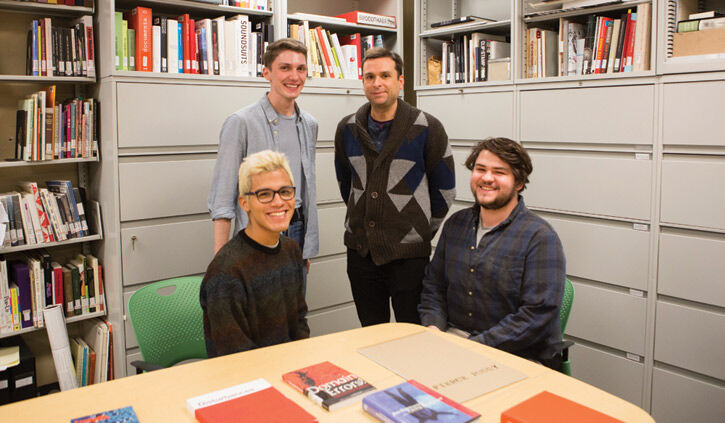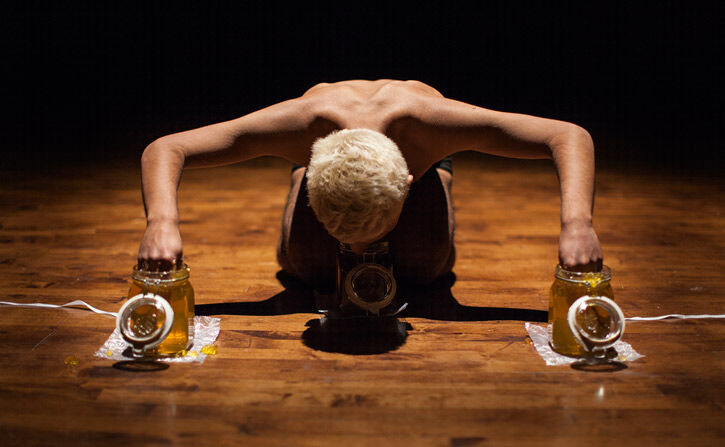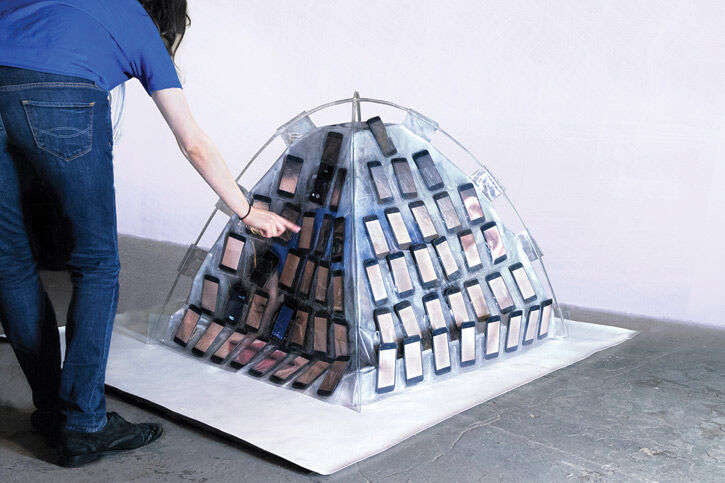
Mixing Realities

by Bridget Esangga
In the 21st century, we live in a mixed reality—between the geophysical world our bodies inhabit, and the virtual worlds in which we project curated versions of ourselves. Three SAIC students are exploring what it means to embody a queer identity in this hybrid world and how virtual constructs affect queer bodies and identities in the physical world.
Luis Mejico (BFA 2017), Cairns Smith (BFA 2015), and Jake Vogds (BFA 2014) formed the Queering Mixed Reality Collective (QMRC) under the guidance of Mark Jeffery, Assistant Professor of Performance at SAIC, and Judd Morrissey, Assistant Professor of Art and Technology Studies at SAIC. The faculty members are part of a performance and technology collective called Anatomical Theatres of Mixed Reality (ATOM-r), which explores “forensics, anatomy, and 21st century embodiment through performance, language and emerging technologies,” according to its website.
When SAIC’s Earl and Brenda Shapiro Center for Research and Collaboration opened the call for its EAGER grants to student groups, Morrissey and Jeffery guided Mejico, Smith, and Vogds’s application. Of the seven groups awarded a grant, QMRC was the only group composed solely of undergraduates to receive one.
“The grant validates that this is a topic that SAIC supports and wants to see more of,” says Mejico. “But it also helps us know that the conversations we’re having are relevant. It allows us to bring in artists to share their work with the students and also to share their work with one another.”
The collective kicked off their project with the Cyber/Queer Space symposium on December 10 at the Joan Flasch Artists’ Book Collection. Artist and SAIC Instructor Matthew Morris presented his work, opening with a photograph titled boys in my bedroom(2013) that shows a male torso reclining on a pink satin quilt. A mobile device is positioned on the chest, a grid displayed on the screen. Morris touched on the history of queerness in art as he talked about a postcard he created with an image of Charles Willson Peale’s painting Staircase Group (1795). The piece depicts two young men ascending a staircase together. On the back of the card, Morris wrote a note to collaborator Sean Robert Fitzgerald and affixed a commemorative US postage stamp of Marsden Hartley’s Painting, Number 5 (1914). Hartley’s colorful canvases are memorials to Karl von Freyburg, a young German officer—and possibly the love of Hartley’s life, according to Morris—who was killed in World War I. Morris then talked about the life these images and others take online on his Tumblr page and how that relates to the physical world.
Morris, along with students and presenters James Theophilos (MFA 2015) and Nu Evil (BFA 2015), was attempting to define queer within technology. “This is a very challenging aspect because on the one hand, there’s queerness as related to sexual preference, sexual orientation, gender identity, gender performance,” says Morrissey. “And on the other hand, there’s just the otherness of the queer—the idea that the queer is something that disrupts the system; the queer is something that contradicts coded expectations. The queer is clearly associated with nonbinaries: not necessarily male, not necessarily female, maybe gay, but maybe not gay or not straight.”
This semester, QMRC will continue to organize events around the topic, including a workshop with the performing group Salonathon. There will be an exhibition and performance event with Zach Blas (Post-Bac 2006), whose ongoing project Facial Weaponization Suite uses the biometrical measurements of gay men to confuse visual recognition patterns. They will host a screening of Blue, the final feature-length film of English Filmmaker Derek Jarman, created before he died from complications from AIDS. And QMRC will integrate their discussion into a class taught by Morrissey and Jeffery this spring called Art and Technology: Mixed Reality/New Technology.

Mejico and Vogds worked with Jeffery and Morrissey before; the faculty members have been combining technology and performance for more than a decade—most recently moving into spatialized, mixed reality performances in which elements are mapped into a space itself or onto the bodies of the performers. In spring 2014, ATOM-r’s the Operatureincorporated an interactive surgical table, text mapped to GPS coordinates, a mobile app, and scannable tattoos on the performers’ bodies. During the performance, a performer scanned the tattoos with a tablet, revealing large-scale projections of photos and videos. During a 15-minute intermission, the audience was invited to scan the performers’ bodies via a smartphone augmented reality app called Layar.
Technical Director Meghan Moe Beitiks (MFA 2013) designed the lighting to be portable, so it had to be moved around the set by performers. Mejico and Vogds played those parts. “They were doing a lot of really precise movements of portable lights. Part of this idea is that everything is a mobile, portable system that’s reconfiguring itself and being rearranged,” says Morrissey. “They were so close to the performers that they were essentially revealing what was happening to the audience.”
Smith had also worked with Jeffery in class. Vogds says, “We started talking and realized that where our grounds met were where ATOM-r’s grounds met—this conversation of contemporary technology and contemporary social technologies and communities that build off of them in terms of the queer community.”
According to Mejico, each member of the group has a vastly different approach to the ideas of queerness and technology. Mejico, for example, uses cyberspace as a source of inspiration, connecting with other artists through websites by asking for submissions that he turns into live performance work.
Vogds uses smart phones as both screens and recording devices. In a piece called UserFace, Vogds gives a pop vocal performance inside a transparent tent to which audience members’ phones are attached. The phones record the performance inside the tent, allowing audience members to watch the performance on their screens from a front-row point of view. “It’s how we experience the world—we’re constantly online, and we’re constantly present in so many different ways,” says Vogds.

In another piece called TrendBody, Vogds looks out from a headgear apparatus with multiple iPhones attached. The piece explores “the duality of being watched, but also watching users online and how that facilitates a community, but also surveillance and homogenizations of identities,” says Vogds.
Smith imagines today “as an extremely crude version of the future.” Despite technological innovations, “we might as well believe the world is flat regarding our progress with social issues,” he says. “Thinking about this in my work, I often find blurred lines everywhere and stolen histories that lead me into research cycles and meditations both real and virtual.”
Perhaps what unites the work of these students and their faculty is a refusal to be defined by the system. They embrace complexity and subvert boundaries to create a mixed reality that does not play by the binary rules of code or gender—a condition of hybridity that Morrissey describes as “neither real nor fake, neither natural nor synthetic, neither male nor female, but something nuanced and modulated by technology.”
If you would like to contact them with ideas for future events, email QMRCollective@gmail.com
